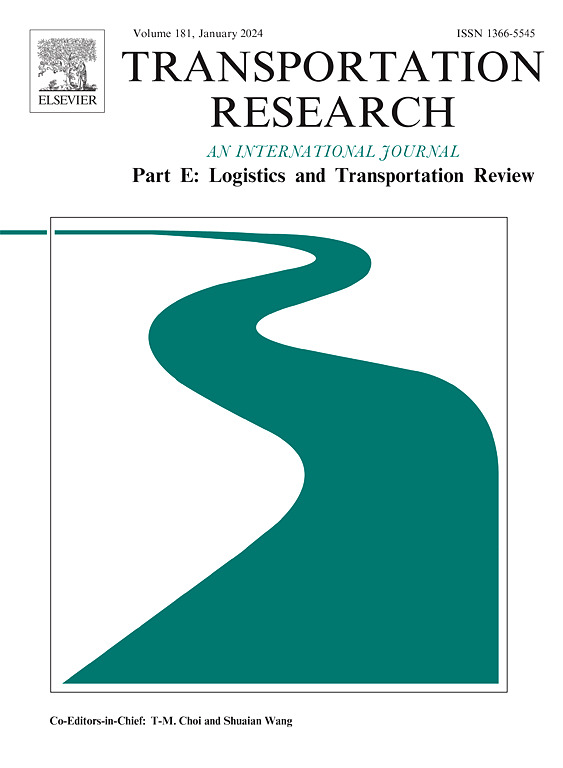城市网络中自动驾驶汽车专用车道的二维车道配置设计方法
IF 8.3
1区 工程技术
Q1 ECONOMICS
Transportation Research Part E-Logistics and Transportation Review
Pub Date : 2025-02-01
DOI:10.1016/j.tre.2024.103938
引用次数: 0
摘要
本研究的重点是优化城市网络中的自动驾驶汽车专用车道(avdl),这是管理自动驾驶汽车(AVs)和人类驾驶汽车(HVs)共存的混合交通的关键步骤。传统的AVDL部署策略主要是优化AVDL的数量,而没有充分考虑交叉口车道的定向功能或不同车道的出行成本。为了解决这些差距,我们提出了一种二维车道配置方法,该方法优化了每个路段上avdl的数量及其针对各种交通运动的定向功能。通过识别与不同车道类型相关的特定路权分配,将交叉口延迟纳入出行成本计算。该方法通过将交通分为AVDL-only路径、混合车道路径和常规车道(RL)-only路径,可以更精确地计算每个车道特定路径上的交通量和旅行成本。提出了一种特定车道用户平衡(UE)模型,以捕捉不同车道类型上的交通动态,并严格证明了UE解决方案的存在性和唯一性。采用双层求解方法有效地解决了AVDL的构型优化问题。该方法将自定义蒙特卡罗树搜索(MCTS)算法与交通调节排序方法相结合,将frank - wolfe型算法与链路修剪技术相结合,提高了计算效率。在一个玩具网络和著名的Sioux-Falls网络上的数值实验证明了所提出的二维AVDL配置方法的有效性和双层求解方法的有效性。本研究通过将AVDL配置扩展到两个维度,为未来混合交通环境下的城市网络设计提供了一个全面的框架。本文章由计算机程序翻译,如有差异,请以英文原文为准。
Two-dimensional lane configuration design approach for Autonomous Vehicle Dedicated Lanes in urban networks
This study focuses on optimizing Autonomous Vehicle Dedicated Lanes (AVDLs) in urban networks, a critical step in managing mixed traffic where autonomous vehicles (AVs) and human-driven vehicles (HVs) coexist. Traditional AVDL deployment strategies have mainly optimized the number of AVDLs without adequately considering the directional functionality of lanes or their various lane-specific travel costs at intersections. To address these gaps, we propose a two-dimensional lane configuration approach that optimizes both the number of AVDLs on each road segment and their directional functionality for various traffic movements. Intersection delays are incorporated into the travel cost computation, through identifying the specific right-of-way allocations associated with different lane types. The proposed approach enables a more precise calculation of traffic volumes and travel costs on each lane-specific path, by categorizing travel into AVDL-only paths, hybrid-lane paths, and regular lane (RL)-only paths. A lane-specific user equilibrium (UE) model is developed to capture traffic dynamics on various lane types, with the existence and uniqueness of the UE solution rigorously proven. The AVDL configuration optimization is efficiently solved using a bi-level solution method. This method integrates a customized Monte Carlo Tree Search (MCTS) algorithm with a traffic accommodation ranking approach and a Frank–Wolfe-type algorithm with a link pruning technique to enhance computational efficiency. Numerical experiments on a toy network and the well-known Sioux-Falls network demonstrate the effectiveness of the proposed two-dimensional AVDL configuration approach and the efficiency of the bi-level solution method. This study contributes to the field by extending AVDL configuration to two dimensions, providing a comprehensive framework for future urban network design in mixed traffic environments.
求助全文
通过发布文献求助,成功后即可免费获取论文全文。
去求助
来源期刊
CiteScore
16.20
自引率
16.00%
发文量
285
审稿时长
62 days
期刊介绍:
Transportation Research Part E: Logistics and Transportation Review is a reputable journal that publishes high-quality articles covering a wide range of topics in the field of logistics and transportation research. The journal welcomes submissions on various subjects, including transport economics, transport infrastructure and investment appraisal, evaluation of public policies related to transportation, empirical and analytical studies of logistics management practices and performance, logistics and operations models, and logistics and supply chain management.
Part E aims to provide informative and well-researched articles that contribute to the understanding and advancement of the field. The content of the journal is complementary to other prestigious journals in transportation research, such as Transportation Research Part A: Policy and Practice, Part B: Methodological, Part C: Emerging Technologies, Part D: Transport and Environment, and Part F: Traffic Psychology and Behaviour. Together, these journals form a comprehensive and cohesive reference for current research in transportation science.

 求助内容:
求助内容: 应助结果提醒方式:
应助结果提醒方式:


